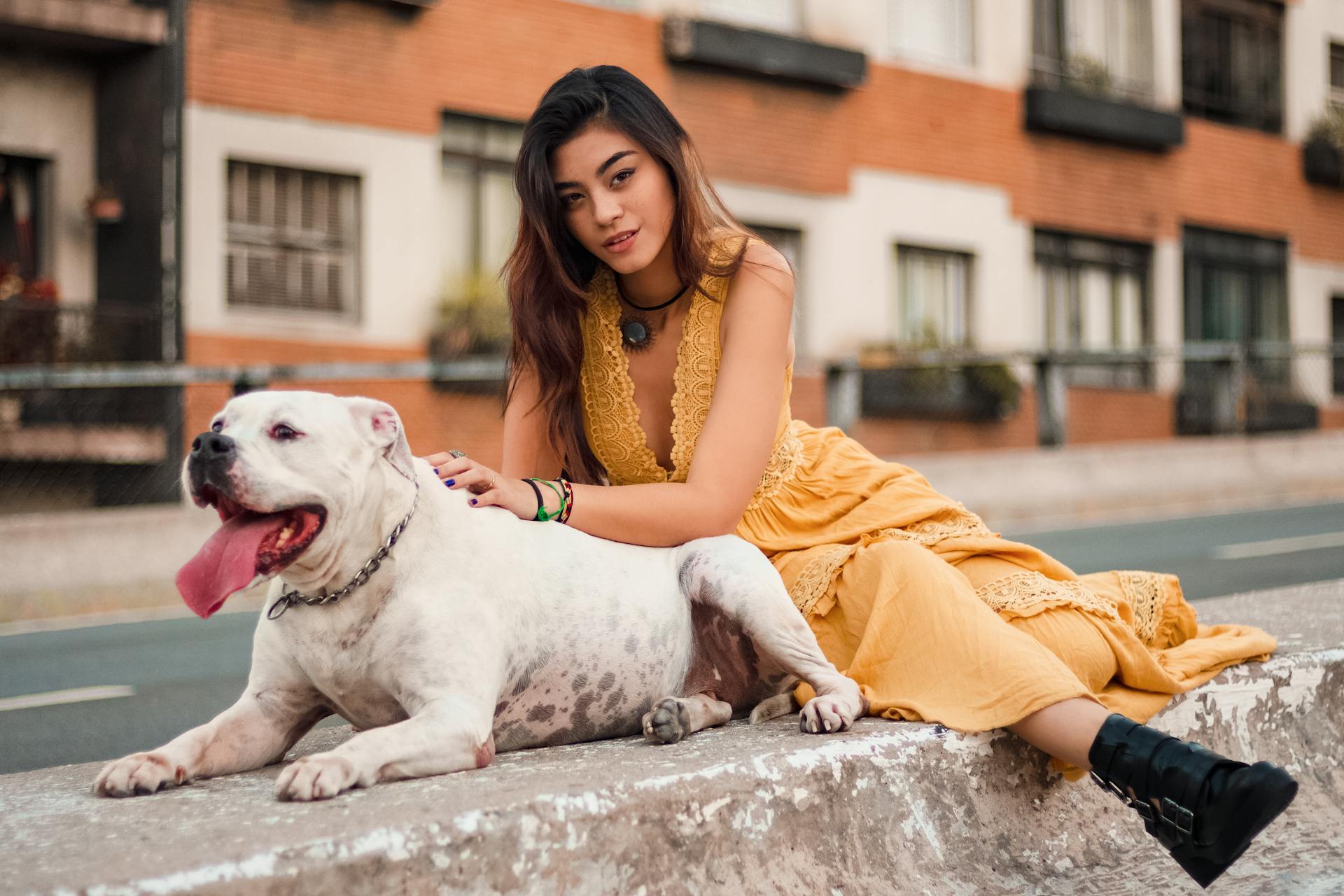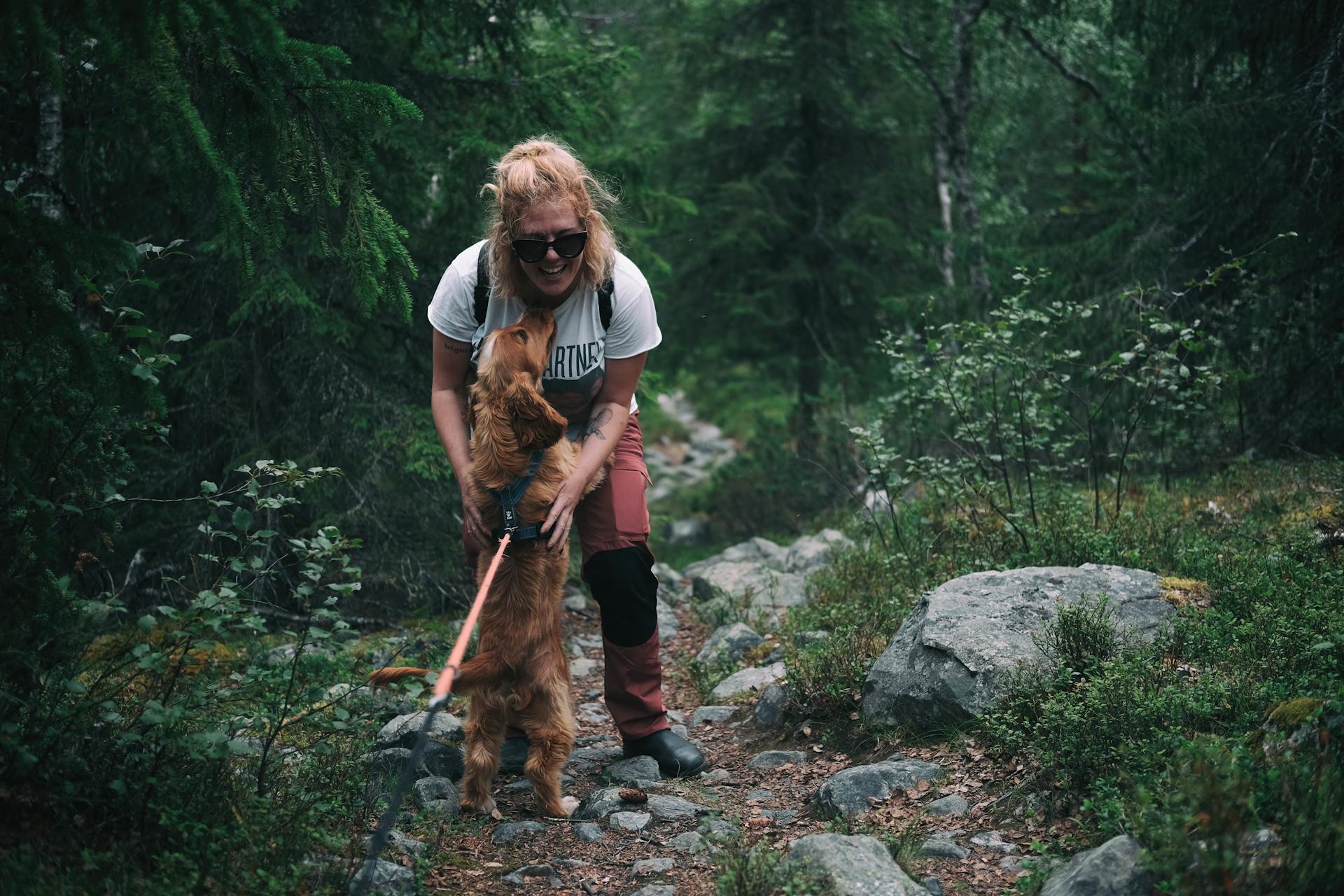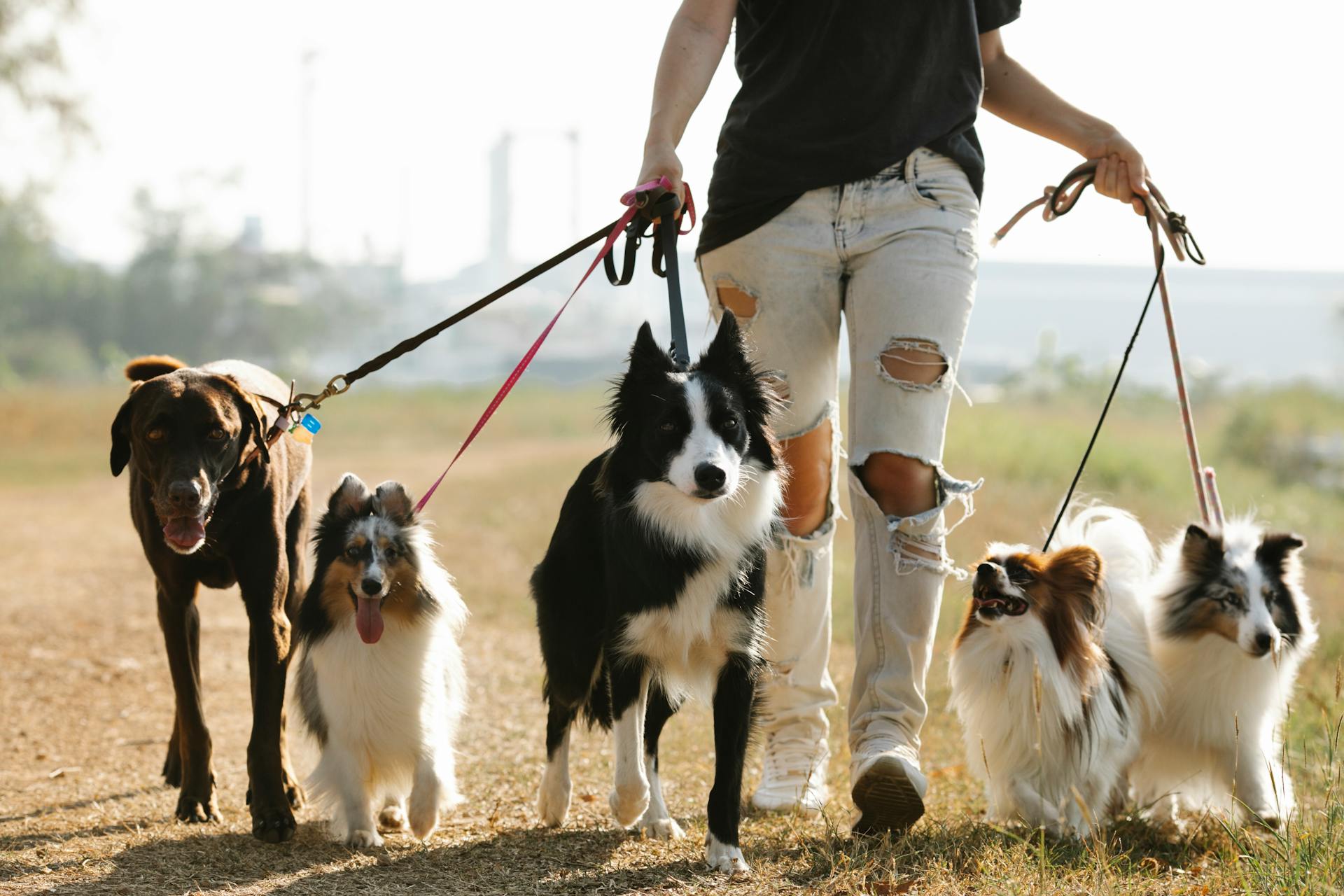
Female dogs flag, or display a flag-like posture, when they're in heat, which typically lasts around 2-3 weeks. This is a natural behavior that occurs every 6-8 months.
During this time, your female dog may become more affectionate and receptive to male dogs. She may also exhibit restless behavior, whining, or pacing.
In a typical heat cycle, your female dog will experience four distinct phases: proestrus, estrus, diestrus, and anestrus. Proestrus is the initial phase, where she'll start to show signs of heat, such as flagging and restlessness.
The estrus phase is when your female dog is most receptive to breeding, usually lasting around 7-10 days.
See what others are reading: Unspayed Female Dog Behavior
Early Signs and Stages
As you're about to witness your female dog flagging, it's essential to recognize the early signs and stages of this behavior.
The first sign of heat in dogs is often swelling of the vulva, which occurs directly below the anus. This swelling will start to appear before your dog goes into heat and will increase to three times its normal size with a reddish color when she's in full heat.
See what others are reading: How to Care for a Female Dog in Heat

Your dog may also exhibit vaginal bleeding, which will decrease in amount and change to a brownish color during heat. Some dogs will constantly lick their vagina, which is another common sign of heat.
In the early stages of heat, your dog may become nervous, agitated, or easily irritated. You may also notice increased mating behaviors, such as mounting other dogs or even your legs.
Here are the common signs of heat in dogs:
Early Signs
As your dog approaches heat, you may notice some early signs that can help you prepare and care for her. During proestrus, the first stage of heat, your dog's reproductive tract prepares for ovulation, but she can't become pregnant yet.
Swelling of the vulva is usually the first symptom of proestrus, followed by bloody vaginal discharge. You may also notice your dog holding or tucking her tail closer to her body, being more clingy, or experiencing changes in appetite.
Expand your knowledge: When Does a Female Dog Have Her First Heat

Other signs of proestrus include increased aggression toward male dogs, which is a natural response to the hormonal changes in her body.
Here are some common signs of proestrus to look out for:
- Swelling of the vulva
- Bloody vaginal discharge
- Holding or tucking her tail closer to her body
- Increased clinginess
- Changes in appetite
- Aggression toward male dogs
As you observe these signs, remember to provide your dog with plenty of love, care, and attention to help her feel comfortable and secure during this time.
Duration of Dog Heat Stages
The duration of dog heat stages can be a bit of a mystery, but it's actually quite predictable. The proestrus phase usually lasts around 9 days.
The estrus phase, also known as the heat phase, is similar in length to proestrus, lasting around 9 days. This is the time when a female dog is most receptive to breeding.
Diestrus is a relatively short phase, lasting around 4 days. During this time, a female dog's reproductive cycle is winding down.
Anestrus is the longest phase of the heat cycle, usually lasting around 5 months. This is the time between estrus and the next proestrus, when a female dog is not receptive to males and her reproductive system is inactive.
Related reading: Female Dog Reproductive
Spaying and Reproduction

Spaying your female dog can have a significant impact on her reproductive health. Approximately 3.1 million dogs enter U.S. animal shelters each year, and spaying is the best way to prevent further unnecessary premature dog deaths.
Spaying can reduce your dog's risk of breast cancer, which is the most common type of tumor in unspayed female dogs. About half of mammary gland tumors in dogs are cancerous.
Spaying before the first heat cycle significantly reduces the risk of breast cancer, with only a 0.5% chance of developing mammary cancer. This risk increases to 8% if spayed between the first and second heat cycles.
Here's a breakdown of the risk of breast cancer in relation to spaying timing:
Spaying can also reduce certain behavioral problems, including aggression, roaming, excessive vocalizing, and urine marking.
Benefits of Spaying
Spaying your dog can have a significant impact on their overall health and well-being. In fact, a 2013 study found that the life expectancy of spayed female dogs was 26.3% longer than that of unspayed dogs.

Spaying reduces the risk of breast cancer, which is the most common type of tumor in unspayed female dogs. About half of mammary gland tumors in dogs are cancerous.
Dogs spayed before their first heat have only a 0.5% risk of developing mammary cancer, making it a crucial decision for pet owners. This risk increases significantly if they're spayed between the first and second heat cycles or after their second heat.
Spaying can also reduce the risk of pyometra, a potentially fatal uterine infection that occurs as a result of hormonal changes in the reproductive tract.
By spaying your dog, you can also reduce certain behavioral problems, including aggression, roaming, excessive vocalizing, and urine marking.
Here's a breakdown of the risks of developing mammary cancer based on the timing of spaying:
Dog Reproduction Cycle Pregnancy Timing
The dog reproduction cycle is a complex process, but understanding the basics can help you prevent unwanted pregnancies. The Female Dogs' Reproduction Cycle lasts 2-3 weeks and is characterized by swelling of the vulva and varying levels of bleeding.

Bleeding is usually heaviest during the Proestrus stage, which lasts for 9 days. A spike in Estrogen marks the beginning of the Estrus stage, and the declining level of Estrogen is met with a rapidly increasing level of LH, or Luteinizing Hormone.
The rapid spike in LH triggers ovulation 2 days later. Dog eggs are unique in that they need to go through a maturation phase, meaning their eggs are ready to be fertilized 2 days after ovulation occurs.
Here's a breakdown of the key stages of the dog reproduction cycle:
A dog will usually go into heat twice a year, with an average interval of six months between each heat, depending on the breed. The heat itself follows a pattern, with the vulva swelling and a bloody discharge in the first week.
Identifying Heat
Swelling of the vulva is a clear sign that your dog is entering heat. Her vulva will start to swell slightly before she goes into heat, and when she's in full heat, it will swell to three times its normal size and take on a reddish color.

Increased mating behaviors are another indication that your dog is in heat. This can include mounting male dogs or other dogs, and she may even try to mount your legs.
Vaginal bleeding is a sign that your dog will soon be going into heat. The amount of blood will decrease quite a bit and the blood will become brownish in color when she's in full heat.
Constantly licking her vagina is a common behavior in female dogs during the early stages of heat. This is a normal sign that your dog is entering heat.
Your dog may start acting strangely, becoming nervous, agitated, or easily irritated, as she enters the early stages of heat. This can be a challenging time for both you and your dog.
Changes in the way your dog positions her tail are another indication that she's in heat. She may curl her tail to one side, making it easier for mating to occur, which is known as 'flagging'.
Here's a quick rundown of the signs your dog may exhibit during heat:
- Swollen vulva
- Vaginal bleeding
- Constantly licking her vagina
- Strange behavior (nervous, agitated, or easily irritated)
- Increased mating behaviors (mounting male or female dogs)
- Changes in tail position (curling to one side)
Understanding Dog Heat
Female dogs in heat are more likely to flag, which means they'll lift their rear end or move their tail to the side, especially when they see a male dog. This behavior is a sign that they're ready to mate.

During the estrus stage, a female dog's vulva will swell to three times its normal size and take on a reddish color. This swelling is a clear indication that she's in heat.
A female dog's discharge will change during the estrus stage, becoming less frequent and lighter in color. It may also become pinkish in color. This change in discharge is a sign that she's ready to be impregnated.
If you notice your female dog is more receptive and friendly towards male dogs, it's a sign that she's in heat. She may also become more aggressive towards other female dogs.
Some common behaviors to look out for in a female dog in heat include increased vocalizing, restless or nervous behavior, and frequent urination. She may even urinate on various objects in the home or outside due to the presence of pheromones and hormones in her urine.
Here are some signs to look out for during the estrus stage:
- Less discharge that's lighter/pinkish in color
- Less swollen vulva
- More receptiveness and friendliness toward male dogs
- Increased vocalizing, especially moaning, whining, yowling, and crying
- More aggression toward female dogs
- Restless or nervous behavior
- Peeing more frequently than normal
- Increased attraction and attention from male dogs
- "Flagging" — lifting her rear toward male dogs or moving her tail to the side
Featured Images: pexels.com


